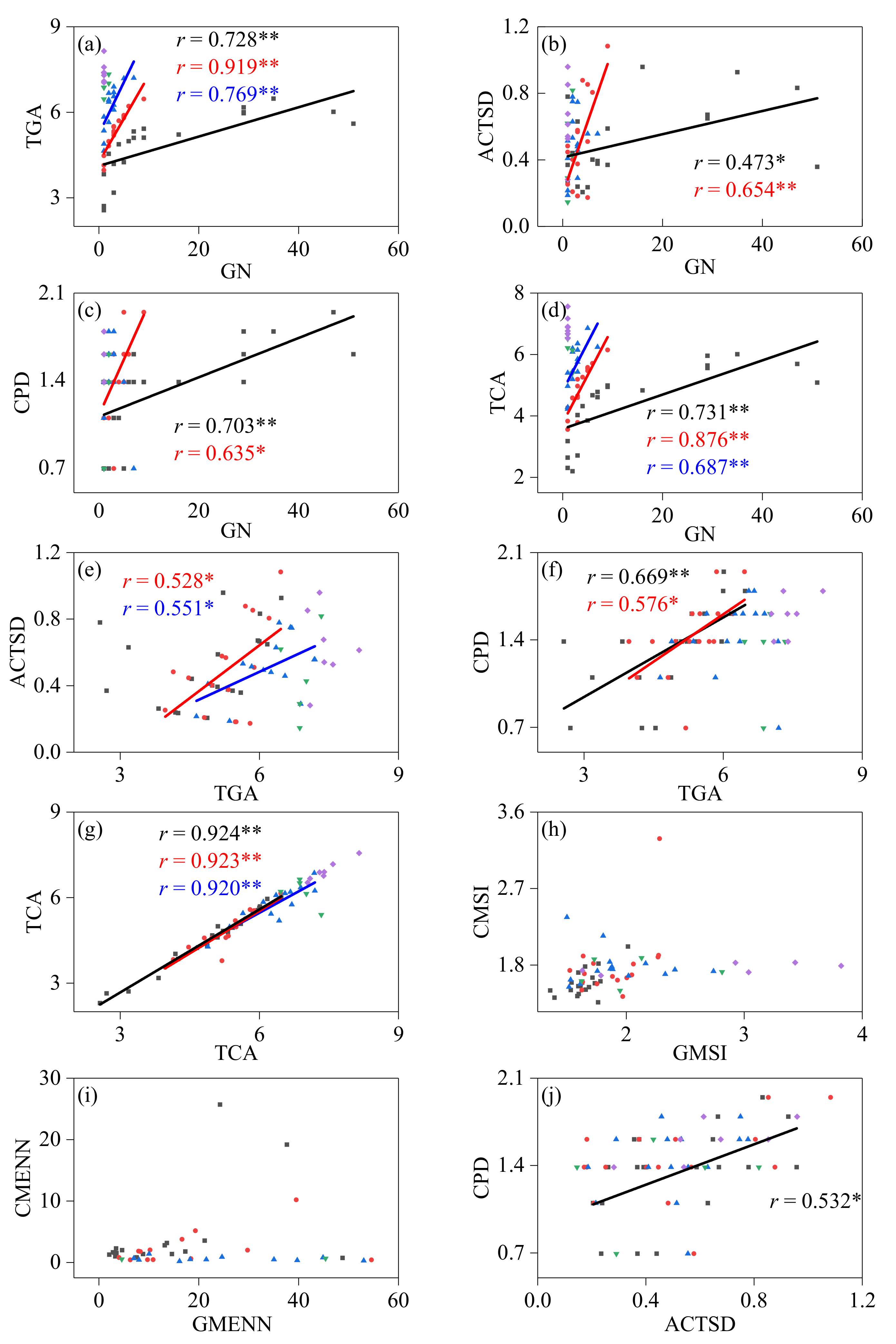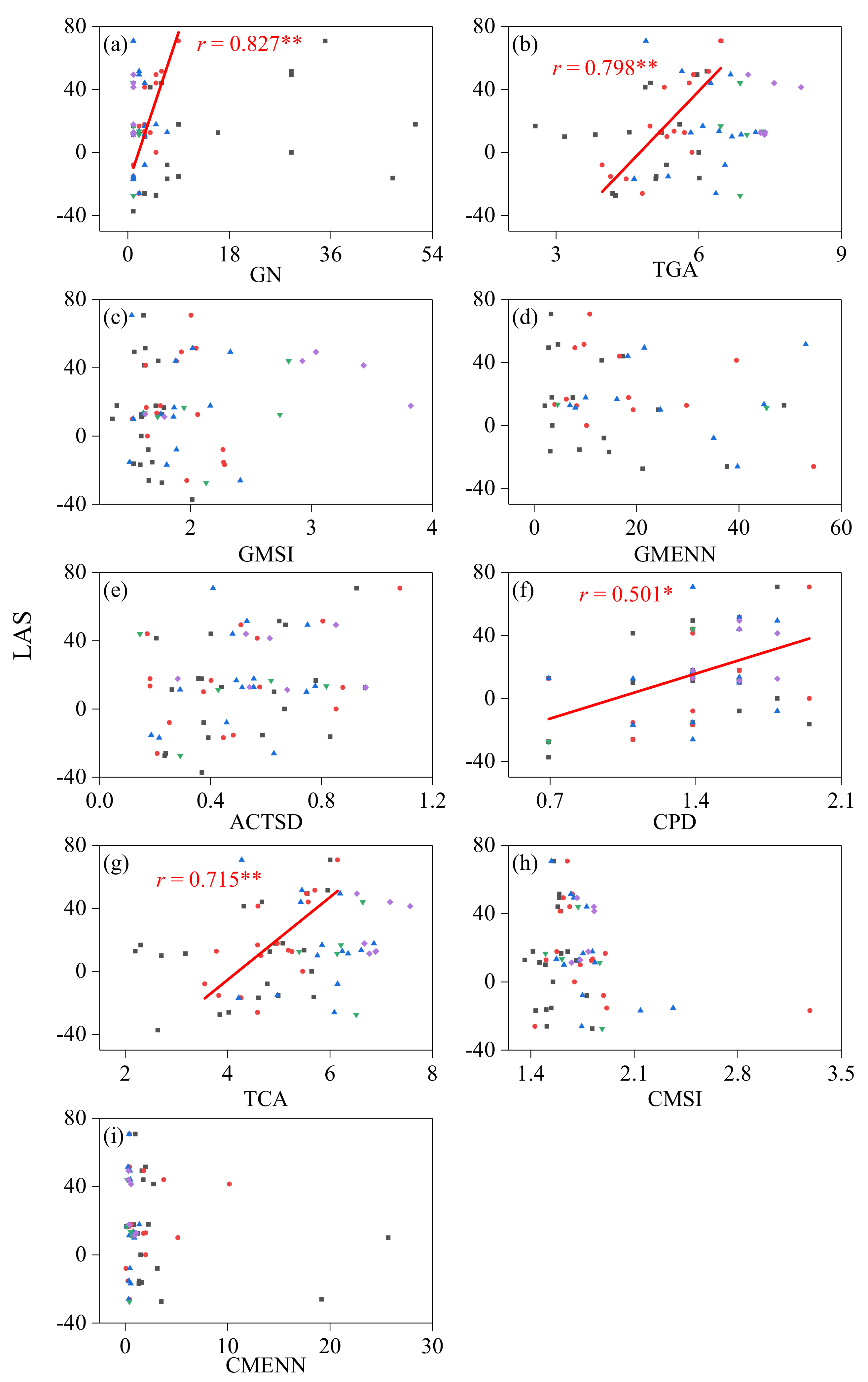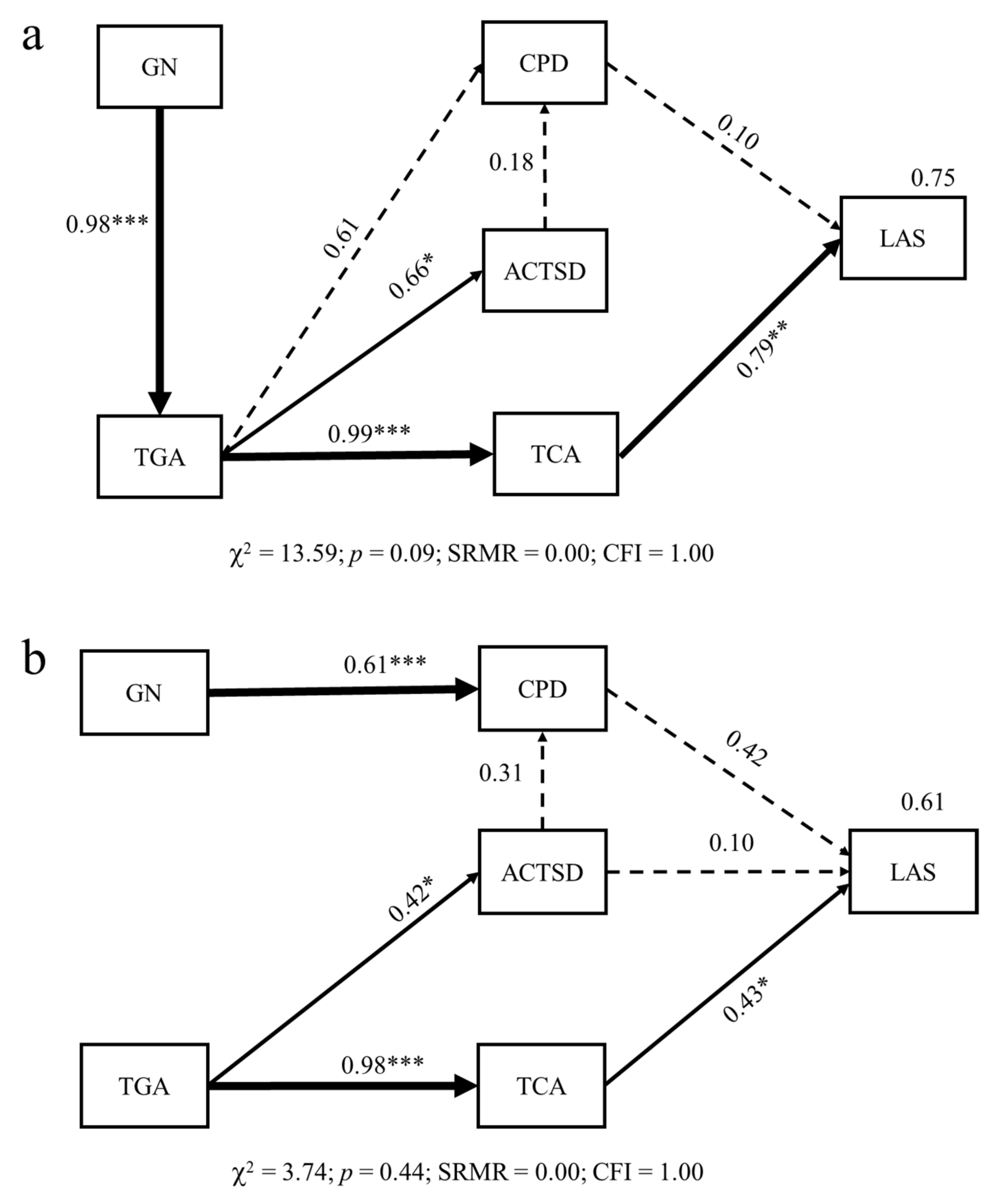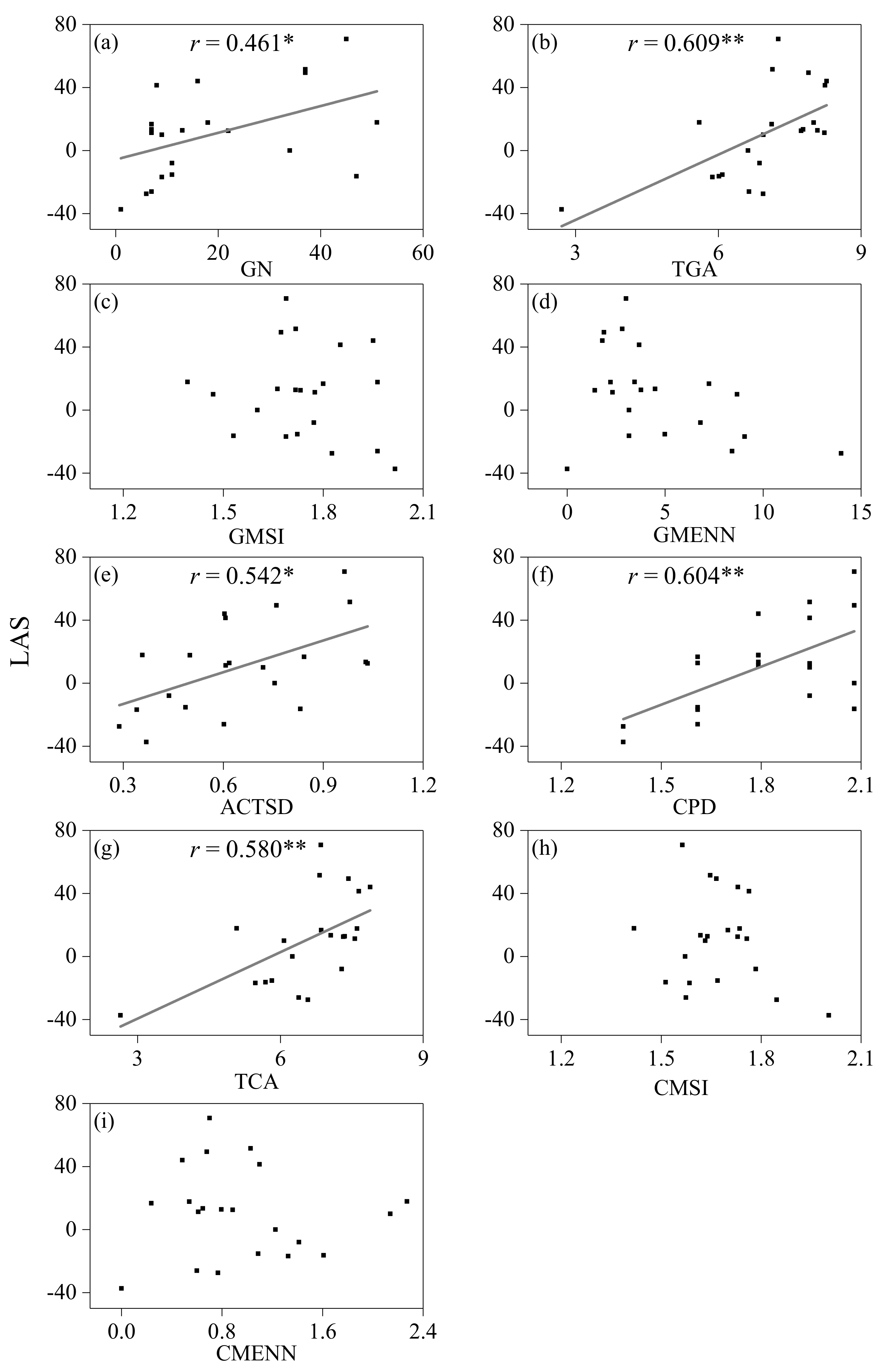Canopy Gaps Improve Landscape Aesthetic Service by Promoting Autumn Color-Leaved Tree Species Diversity and Color-Leaved Patch Properties in Subalpine Forests of Southwestern China
Abstract
:1. Introduction
2. Materials and Methods
2.1. Study Area
2.2. Gap Characteristics Measurement
2.3. Autumn Color-Leaved Tree Species Diversity Measurement
2.4. Color-Leaved Patch Structure Attribute Measurement
2.5. Landscape Aesthetic Service Measurement
2.6. Data Analysis
3. Results
3.1. Gap Characteristics
3.2. Effects of Canopy Gaps on Autumn Color-Leaved Tree Species Diversity and Color-Leaved Patch Structure Attributes
3.3. Effects of Canopy Gaps on Landscape Aesthetic Service
4. Discussion
4.1. Impact of Canopy Gaps on Autumn Color-Leaved Tree Species Diversity and Color-Leaved Patch Structure Attributes
4.2. Influences of Canopy Gaps on Landscape Aesthetic Service Are Mediated through Color-Leaved Species Diversity, Color-Leaved Patch Diversity, and Color-Leaved Patch Area
5. Conclusions
Supplementary Materials
Author Contributions
Funding
Institutional Review Board Statement
Informed Consent Statement
Data Availability Statement
Acknowledgments
Conflicts of Interest
References
- Watt, A.S. Pattern and process in the plant community. J. Ecol. 1947, 1, 1–22. [Google Scholar] [CrossRef] [Green Version]
- Lertzman, K.P.; Sutherland, G.D.; Inselberg, A.; Saunders, S.C. Canopy gaps and the landscape mosaic in a coastal temperate rain forest. Ecology 1996, 77, 1254–1270. [Google Scholar] [CrossRef]
- Chávez, V.; Macdonald, S.E. The influence of canopy patch mosaics on understory plant community composition in boreal mixedwood forest. For. Ecol. Manag. 2010, 259, 1067–1075. [Google Scholar] [CrossRef]
- Zang, R.; Wang, B. Study on canopy disturbance regime and mechanism of tree species diversity maintenance in the lower subtropical evergreen broad-leaved forest, South China. Plant Biosyst. 2002, 136, 241–250. [Google Scholar] [CrossRef]
- Brokaw, N.; Busing, R.T. Niche versus chance and tree diversity in forest gaps. Trends Ecol. Evol. 2000, 15, 183–188. [Google Scholar] [CrossRef]
- Yamamoto, S. Forest gap dynamics and tree regeneration. J. For. Res. 2000, 1, 223–229. [Google Scholar] [CrossRef]
- Wang, Y.; Tao, J.; Li, Y.; Yu, X.; Xi, Y. Effects of Fargesia nitida on species diversity and trees Regeneration in different forest cycles of subalpine forest in Wolong Nature Reserve. Sci. Silvae Sin. 2007, 43, 1–7. [Google Scholar] [CrossRef]
- Zang, R.; Tao, J.; Li, C. Within community patch dynamics in a tropical montane rain forest of Hainan Island, South China. Acta Oecologica 2005, 28, 39–48. [Google Scholar] [CrossRef]
- Wang, W.; Hu, K.; Tao, J.; Li, Z. The regeneration of tree species in subalpine dark coniferous forest in the Wolong Nature Reserve. J. Wuhan Bot. Res. 2006, 24, 130–134. [Google Scholar] [CrossRef]
- Kuper, R. Effects of flowering, foliation, and autumn colors on preference and restorative potential for designed digital landscape models. Environ. Behav. 2018, 52, 1–13. [Google Scholar] [CrossRef]
- Gobster, P.H.; Nassauer, J.I.; Daniel, T.C.; Fry, G. The shared landscape: What does aesthetics have to do with ecology? Landsc. Ecol. 2007, 22, 959–972. [Google Scholar] [CrossRef]
- Daniel, T.C.; Muhar, A.; Arnberger, A.; Aznar, O.; Boyd, J.W.; Chan, K.M.A.; Costanza, R.; Elmqvist, T.; Flint, C.G.; Gobster, P.H.; et al. Contributions of cultural services to the ecosystem services agenda. Proc. Natl. Acad. Sci. USA 2012, 109, 8812–8819. [Google Scholar] [CrossRef] [Green Version]
- Tribot, A.; Deter, J.; Mouquet, N. Integrating the aesthetic value of landscapes and biological diversity. Proc. Biol. Sci. 2018, 285, 20180971. [Google Scholar] [CrossRef] [PubMed]
- Lindemann-Matthies, P.; Marty, T. Does ecological gardening increase species richness and aesthetic quality of a garden? Biol. Conserv. 2013, 159, 37–44. [Google Scholar] [CrossRef]
- Tribot, A.; Mouquet, N.; Villéger, S.; Raymond, M.; Hoff, F.; Boissery, P.; Holon, F.; Deter, J. Taxonomic and functional diversity increase the aesthetic value of coralligenous reefs. Sci. Rep. 2016, 6, 34229. [Google Scholar] [CrossRef] [PubMed] [Green Version]
- Daniel, T.C. Whither scenic beauty? Visual landscape quality assessment in the 21st century. Landsc. Urban Plan. 2001, 54, 267–281. [Google Scholar] [CrossRef]
- Dudek, T. Influence of selected features of forests on forest landscape aesthetic value- example of Se Poland. J. Env. Eng. Landsc. 2018, 26, 275–284. [Google Scholar] [CrossRef] [Green Version]
- Zhang, Z.; Qie, G.; Wang, C.; Jiang, S.; Li, X.; Li, M. Relationship between forest color characteristics and scenic beauty: Case study analyzing pictures of mountainous forests at sloped positions in Jiuzhai Valley, China. Forests 2017, 8, 63. [Google Scholar] [CrossRef]
- Liu, J.; Chamberlain, B.C.; Kozak, R.A.; Meitner, M.J.; Nesbitt, L. Relating shape to human aesthetic evaluations of harvest blocks from an aerial perspective. Scand. J. For. Res. 2018, 33, 793–799. [Google Scholar] [CrossRef]
- Ma, B.; Hauer, R.J.; Xu, C. Effects of design oroportion and distribution of color in urban and suburban green space planning to visual aesthetics quality. Forests 2020, 11, 278. [Google Scholar] [CrossRef] [Green Version]
- Schliemann, S.A.; Bockheim, J.G. Methods for studying treefall gaps: A review. For. Ecol. Manag. 2011, 261, 1143–1151. [Google Scholar] [CrossRef]
- Nakashizuka, T.; Katsuki, T.; Tanaka, H. Forest canopy structure analyzed by using aerial photographs. Ecol. Res. 1995, 1, 13–18. [Google Scholar] [CrossRef]
- Nyamgeroh, B.B.; Groen, T.A.; Weir, M.J.C.; Dimov, P.; Zlatanov, T. Detection of forest canopy gaps from very high resolution aerial images. Ecol. Indic. 2018, 95, 629–636. [Google Scholar] [CrossRef]
- Getzin, S.; Nuske, R.; Wiegand, K. Using unmanned aerial vehicles (UAV) to quantify spatial gap patterns in forests. Remote Sens. 2014, 6, 6988–7004. [Google Scholar] [CrossRef] [Green Version]
- Getzin, S.; Wiegand, K.; Schöning, I. Assessing biodiversity in forests using very high-resolution images and unmanned aerial vehicles. Methods Ecol. Evol. 2012, 3, 397–404. [Google Scholar] [CrossRef]
- Liu, Y.; Zhang, J.; Yang, W.; Wu, F.; Xu, Z.; Tan, B.; Zhang, L.; He, X.; Guo, L. Canopy gaps accelerate soil organic carbon retention by soil microbial biomass in the organic horizon in a subalpine fir forest. Appl. Soil Ecol. 2018, 125, 169–176. [Google Scholar] [CrossRef]
- Zhang, X.; Chen, J.; Li, Q.; Liu, J.; Tao, J. Color quantification and evaluation of landscape aesthetic quality for autumn landscape forest based on visual characteristics in subalpine region of western Sichuan, China. Chin. J. Appl. Ecol. 2020, 31, 45–54. [Google Scholar] [CrossRef]
- Wu, C.; Cheng, C.; Chang, C.; Lin, C.; Chang, K.; Chuang, Y. Gap shape classification using landscape indices and multivariate statistics. Sci. Rep. 2016, 6, 1–10. [Google Scholar] [CrossRef]
- Daniel, T.C.; Boster, R.S. Measuring Landscape Esthetics: The Scenic Beauty Estimation Method; USDA Forest Service Research Paper; USDA: Washington, DC, USA, 1976.
- Wang, W.; Tao, J.; Li, Z.; Zhang, W.; Ding, Y. Gap features of subalpine dark coniferous forest in Wolong Nature Reserve. Chin. J. Appl. Ecol. 2004, 15, 1989–1993. [Google Scholar] [CrossRef]
- Liu, Q.; Wu, Y. Effects of gap size on regeneration of subalpine coniferous forests in northwest Yunnan. Chin. J. Appl. Environ. Biol. 2002, 8, 453–459. [Google Scholar] [CrossRef]
- Grace, J.; Anderson, T.; Olff, H.; Scheiner, S. On the specification of structural equation models for ecological systems. Ecol. Monogr. 2010, 80, 67–87. [Google Scholar] [CrossRef] [Green Version]
- Menges, E.S.; Craddock, A.; Salo, J.; Zinthefer, R.; Weekley, C.W. Gap ecology in Florida scrub: Species occurrence, diversity and gap properties. J. Veg. Sci. 2008, 19, 503–514. [Google Scholar] [CrossRef]
- Mallik, A.U.; Kreutzweiser, D.P.; Spalvieri, C.M. Forest regeneration in gaps seven years after partial harvesting in riparian buffers of boreal mixedwood streams. For. Ecol. Manag. 2014, 312, 117–128. [Google Scholar] [CrossRef]
- Weber, T.A.; Hart, J.L.; Schweitzer, C.J.; Dey, D.C. Influence of gap-scale disturbance on developmental and successional pathways in Quercus-Pinus stands. For. Ecol. Manag. 2014, 331, 60–70. [Google Scholar] [CrossRef]
- Busing, R.T.; White, P.S. Species diversity and small-scale disturbance in an old-growth temperate forest: A consideration of gap partitioning concepts. Oikos 1997, 78, 562–568. [Google Scholar] [CrossRef] [Green Version]
- Xu, W.; Ci, X.; Song, C.; He, T.; Zhang, W.; Li, Q.; Li, J. Soil phosphorus heterogeneity promotes tree species diversity and phylogenetic clustering in a tropical seasonal rainforest. Ecol. Evol. 2016, 6, 8719–8726. [Google Scholar] [CrossRef]
- Kumar, P.; Chen, H.Y.H.; Thomas, S.C.; Shahi, C. Linking resource availability and heterogeneity to understorey species diversity through succession in boreal forest of Canada. J. Ecol. 2018, 106, 1266–1276. [Google Scholar] [CrossRef]
- Denslow, J. Tropical rainforest gaps and tree species diversity. Annu. Rev. Ecol. Syst. 1987, 18, 431–451. [Google Scholar] [CrossRef]
- Hubbell, S.P.; Foster, R.B.; O’Brien, S.T.; Harms, K.E.; Condit, R.; Wechsler, B.; Wright, S.J.S.; Loo de Lao, S. Light-gap disturbances, recruitment limitation, and tree diversity in a neotropical forest. Science 1999, 283, 554–557. [Google Scholar] [CrossRef] [Green Version]
- Dee, J.R.; Menges, E.S. Gap ecology in the Florida scrubby flatwoods: Effects of time-since-fire, gap area, gap aggregation and microhabitat on gap species diversity. J. Veg. Sci. 2014, 25, 1235–1246. [Google Scholar] [CrossRef]
- Whitmore, T.C. Canopy gaps and the two major groups of forest trees. Ecology 1989, 70, 536–538. [Google Scholar] [CrossRef]
- Brokaw, N.V.L.; Scheiner, S.M. Species composition in gaps and structure of a tropical forest. Ecology 1989, 70, 538–541. [Google Scholar] [CrossRef]
- Schnitzer, S.A.; Carson, W.P. Treefall gaps and the maintenance of plant species diversity in a tropical forest. Ecology 2001, 82, 913–919. [Google Scholar] [CrossRef]
- Preston, F.W. The canonical distribution of commonness and rarity: Part I. Ecology 1962, 2, 185–215. [Google Scholar] [CrossRef]
- Busing, R.T. Composition, Structure and Diversity of Cove Forest Stands in the Great Smoky Mountains: A Patch Dynamics Perspective. J. Veg. Sci. 1998, 9, 881–890. [Google Scholar] [CrossRef]
- Manabe, T.; Shimatani, K.; Kawarasaki, S.; Aikawa, S.; Yamamoto, S. The patch mosaic of an old-growth warm-temperate forest: Patch-level descriptions of 40-year gap-forming processes and community structures. Ecol. Res. 2009, 24, 575–586. [Google Scholar] [CrossRef]
- Grose, M.J. Plant colour as a visual aspect of biological conservation. Biol. Conserv. 2012, 153, 159–163. [Google Scholar] [CrossRef]
- Runkle, J.R. Patterns of disturbance in some old-growth mesic forests of eastern north America. Ecology 1982, 63, 1533–1546. [Google Scholar] [CrossRef] [Green Version]
- Arriaga, L. Gap-building-phase regeneration in a tropical montane cloud forest of north-eastern Mexico. J. Trop. Ecol. 2000, 16, 535–562. [Google Scholar] [CrossRef]
- Li, P. The Influence of Space Characteristics of Color Patch on the Autumn Aesthetic Quality of the Forest of Cotinus coggygria. Master’s Thesis, Beijing Forestry University, Beijing, China, 2018. [Google Scholar]
- Quijas, S.; Jackson, L.E.; Maass, M.; Schmid, B.; Raffaelli, D.; Balvanera, P. Plant diversity and generation of ecosystem services at the landscape scale: Expert knowledge assessment. J. Appl. Ecol. 2012, 49, 929–940. [Google Scholar] [CrossRef] [Green Version]
- Lindemann-Matthies, P.; Junge, X.; Matthies, D. The influence of plant diversity on people’s perception and aesthetic appreciation of grassland vegetation. Biol. Conserv. 2010, 143, 195–202. [Google Scholar] [CrossRef] [Green Version]
- Hoyle, H.; Norton, B.; Dunnett, N.; Richards, J.P.; Russell, J.M.; Warren, P. Plant species or flower colour diversity? Identifying the drivers of public and invertebrate response to designed annual meadows. Landsc. Urban Plan. 2018, 180, 103–113. [Google Scholar] [CrossRef]
- Graves, R.A.; Pearson, S.M.; Turner, M.G. Species richness alone does not predict cultural ecosystem service value. Proc. Natl. Acad. Sci. USA 2017, 114, 3774–3779. [Google Scholar] [CrossRef] [Green Version]
- Cowell, C.M.; Hoalst-Pullen, N.; Jackson, M.T. The limited role of canopy gaps in the successional dynamics of a mature mixed Quercus forest remnant. J. Veg. Sci. 2010, 21, 201–212. [Google Scholar] [CrossRef]
- Petritan, A.M.; Nuske, R.S.; Petritan, I.C.; Tudose, N.C. Gap disturbance patterns in an old-growth sessile oak (Quercus petraea L.)—European beech (Fagus sylvatica L.) forest remnant in the Carpathian Mountains, Romania. For. Ecol. Manag. 2013, 308, 67–75. [Google Scholar] [CrossRef]








| ≤50 m2 | 51–100 m2 | 101–500 m2 | 501–1000 m2 | >1000 m2 | p | |
|---|---|---|---|---|---|---|
| GSI | 1.57 ± 0.01 c | 1.83 ± 0.05 b | 1.91 ± 0.06 ab | 1.94 ± 0.17 ab | 2.78 ± 0.30 a | 0.000 |
| ACTSD | 0.35 ± 0.01 c | 0.51 ± 0.03 b | 0.60 ± 0.04 ab | 0.74 ± 0.14 ab | 1.00 ± 0.12 a | 0.000 |
| CPD | 0.84 ± 0.03 b | 1.25 ± 0.04 a | 1.29 ± 0.05 a | 1.35 ± 0.12 a | 1.60 ± 0.06 a | 0.000 |
| CA | 2.14 ± 0.06 c | 4.25 ± 0.03 b | 5.37 ± 0.07 ab | 6.59 ± 0.09 ab | 7.42 ± 0.14 a | 0.000 |
| CSI | 1.57 ± 0.02 b | 1.88 ± 0.05 a | 1.84 ± 0.07 a | 1.83 ± 0.07 a | 1.78 ± 0.04 a | 0.000 |
| S | M | L | VL | EL | p | |
|---|---|---|---|---|---|---|
| GN | 14.70 ± 3.57 a | 3.50 ± 0.53 b | 2.60 ± 0.42 bc | 1.40 ± 0.24 bc | 1.00 ± 0.00 c | 0.000 |
| TGA | 4.88 ± 0.25 c | 5.32 ± 0.18 bc | 6.18 ± 0.20 ab | 6.91 ± 0.14 a | 7.42 ± 0.14 a | 0.000 |
| GMSI | 1.64 ± 0.03 b | 1.89 ± 0.06 a | 1.92 ± 0.09 a | 2.04 ± 0.21 a | 2.77 ± 0.36 a | 0.000 |
| GMENN | 13.92 ± 3.4 | 18.15 ± 4.12 | 25.31 ± 4.74 | 24.99 ± 20.42 | – | 0.131 |
| ACTSD | 0.52 ± 0.05 | 0.50 ± 0.07 | 0.51 ± 0.05 | 0.46 ± 0.12 | 0.64 ± 0.08 | 0.626 |
| CPD | 1.34 ± 0.08 | 1.43 ± 0.08 | 1.43 ± 0.08 | 1.29 ± 0.16 | 1.60 ± 0.06 | 0.306 |
| TCA | 4.40 ± 0.28 c | 4.88 ± 0.19 c | 5.64 ± 0.21 b | 6.42 ± 0.10 ab | 6.93 ± 0.13 a | 0.000 |
| CMSI | 1.59 ± 0.03 b | 1.80 ± 0.11 a | 1.78 ± 0.05 a | 1.72 ±0.07 ab | 1.76 ± 0.03 a | 0.006 |
| CMENN | 3.98 ± 1.62 a | 2.01 ± 0.69 ab | 0.55 ± 0.08 b | 0.40 ± 0.09 b | 0.59 ± 0.13 b | 0.001 |
Publisher’s Note: MDPI stays neutral with regard to jurisdictional claims in published maps and institutional affiliations. |
© 2021 by the authors. Licensee MDPI, Basel, Switzerland. This article is an open access article distributed under the terms and conditions of the Creative Commons Attribution (CC BY) license (http://creativecommons.org/licenses/by/4.0/).
Share and Cite
Li, Q.; Du, Y.; Liu, Y.; Chen, J.; Zhang, X.; Liu, J.; Tao, J. Canopy Gaps Improve Landscape Aesthetic Service by Promoting Autumn Color-Leaved Tree Species Diversity and Color-Leaved Patch Properties in Subalpine Forests of Southwestern China. Forests 2021, 12, 199. https://doi.org/10.3390/f12020199
Li Q, Du Y, Liu Y, Chen J, Zhang X, Liu J, Tao J. Canopy Gaps Improve Landscape Aesthetic Service by Promoting Autumn Color-Leaved Tree Species Diversity and Color-Leaved Patch Properties in Subalpine Forests of Southwestern China. Forests. 2021; 12(2):199. https://doi.org/10.3390/f12020199
Chicago/Turabian StyleLi, Qiaoyu, Yu Du, Yuan Liu, Juan Chen, Xiaojing Zhang, Jinchun Liu, and Jianping Tao. 2021. "Canopy Gaps Improve Landscape Aesthetic Service by Promoting Autumn Color-Leaved Tree Species Diversity and Color-Leaved Patch Properties in Subalpine Forests of Southwestern China" Forests 12, no. 2: 199. https://doi.org/10.3390/f12020199





